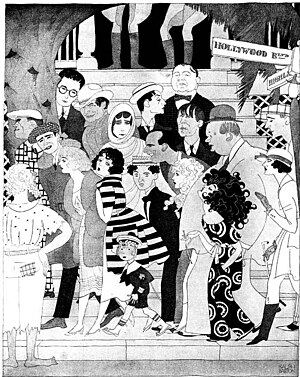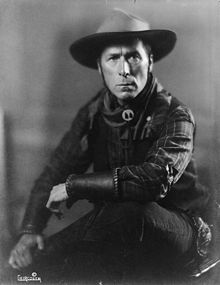William S. Hart
William Surrey Hart (December 6, 1864 – June 23, 1946) was an American silent film actor, screenwriter, director and producer.[1] He is best remembered for his heroic roles in Westerns, it has been said that "though Hart could be cast as a villain, he imbued all of his characters with honor and integrity."[2]
Biography
Hart was born in Newburgh, New York; to James Howard Hart (1829–1902) and Katherine Diédricht Hart (1833–1909). William had 2 brothers and 4 sisters. His father was of Irish ancestry, and his mother was of German heritage. In his twenties, Hart began his acting career on stage and would not consider acting in movies until he was 49 years of age.[3] He toured and traveled extensively while trying to make a name for himself as an actor, and for a time coached shows at the Asheville Opera House around year 1900. His family had moved to Asheville but after his youngest sister Lotta died of typhoid fever they all left together for Brooklyn until William went back on tour.[4]

A successful Shakespearean actor on Broadway who had worked with Margaret Mather and other stars, he appeared in the original 1899 stage production of Ben-Hur.
Hart went on to become one of the first great stars of the motion picture western. Fascinated by the Old West, he acquired Billy the Kid's "six shooters" and was a friend of legendary lawmen Wyatt Earp and Bat Masterson. He entered films in 1914 where, after playing supporting roles in two short films, he achieved stardom as the lead in the feature The Bargain. Hart was particularly interested in making realistic western films. His films are noted for their authentic costumes and props, as well as Hart's extraordinary acting ability, honed on Shakespearean theater stages in the United States and England.
Beginning in 1915, Hart starred in his own series of two-reel western short subjects for producer Thomas Ince, which were so popular that they were supplanted by a series of feature films. Many of Hart's early films continued to play in theaters, under new titles, for another decade. In 1917 Hart accepted a lucrative offer from Adolph Zukor to join Famous Players-Lasky, which merged into Paramount Pictures. In the films Hart began to ride a brown and white pinto he called Fritz. Fritz was the forerunner of later famous movie horses known by their own name, i.e., horses like Tom Mix's Tony, Roy Rogers's Trigger and Clayton Moore's Silver, etc. Hart was now making feature films exclusively, and films like Square Deal Sanderson and The Toll Gate were popular with fans. Hart married young Hollywood actress Winifred Westover. Although their marriage was short-lived, they had one child, William S. Hart, Jr.(1922–2004).
By the early 1920s, however, Hart's brand of gritty, rugged westerns with drab costumes and moralistic themes gradually fell out of fashion. The public became attracted by a new kind of movie cowboy, epitomized by Tom Mix, who wore flashier costumes and was faster with the action. Paramount dropped Hart, who then made one last bid for his kind of western. He produced Tumbleweeds (1925) with his own money, arranging to release it independently through United Artists. The film turned out well, with an epic land-rush sequence, but did only fair business at the box office. Hart was angered by United Artists' failure to promote his film properly and sued United Artists. The legal proceedings dragged on for years, and the courts finally ruled in Hart's favor, in 1940.

After Tumbleweeds, Hart retired to his Newhall, California, ranch home, “La Loma de los Vientos,” which was designed by architect Arthur R. Kelly. In 1939 he appeared in his only sound film, a spoken prologue for a reissue of Tumbleweeds. The 75-year-old Hart, filmed on location at his Newhall ranch, reflects on the Old West and recalls his silent-movie days fondly. The speech turned out to be William S. Hart's farewell to the screen, and it's a fitting valedictory. Most prints and video versions of Tumbleweeds circulating today include Hart's speech. Hart died on June 23, 1946, in Newhall, California at the age of 81. He was buried in Green-Wood Cemetery in Brooklyn, New York.
Dedications

For his contribution to the motion picture industry, William S. Hart has a star on the Hollywood Walk of Fame at 6363 Hollywood Blvd. In 1975, he was inducted into the Western Performers Hall of Fame at the National Cowboy & Western Heritage Museum in Oklahoma City, Oklahoma.
As part of the Natural History Museum of Los Angeles County, California, Hart's former home and 260-acre (1.1 km²) ranch in Newhall is now William S. Hart Park. The William S. Hart High School District as well as William S. Hart Senior High School, both located in the Santa Clarita Valley in the northern part of Los Angeles County, were named in his honor.
On November 10, 1962, Hart was honored posthumously in an episode of the short-lived The Roy Rogers and Dale Evans Show, a western variety program on ABC.
References
- ^ Obituary Variety, June 26, 1946, page 62.
- ^ |publisher=The Los Angeles Times
- ^ William S. Hart Ranch and Museum
- ^ [1]
- ^ "When the Five O'Clock Whistle Blows in Hollywood". Vanity Fair. September 1922. Retrieved 27 June 2017.
Further reading

- William Surrey Hart, My Life East and West, New York: Houghton Mifflin Company, 1929.
- David W. Menefee, The First Male Stars: Men of the Silent Era, Albany: Bear Manor Media, 2007.
- Jeanine Basinger, Silent Stars, 1999 (ISBN 0-8195-6451-6). (chapter on William S. Hart and Tom Mix)
- Ronald L. Davis, William S. Hart: Projecting the American West, University of Oklahoma Press, 2003.
External links
- William S. Hart at IMDb
- William S. Hart at the Internet Broadway Database
- William S. Hart Ranch and Museum
- "William S. Hart History". Santa Clarita Valley Historical Society. Retrieved 2004-07-04. (Photos & text)
- William S. Hart Photos and History
- Ron Schuler's Parlour Tricks: The Good Badman
- The Haunted Hart Ghost Site
- William S. Hart Union High School District, Santa Clarita Valley, California
- William S. Hart High School, Newhall, California
- Photographs of William S. Hart
- William S. Hart at Find a Grave
- American film actors
- American silent film actors
- American screenwriters
- American film directors
- American film producers
- Western (genre) film actors
- Western (genre) film directors
- American people of Irish descent
- American people of German descent
- Burials at Green-Wood Cemetery
- 1864 births
- 1946 deaths
- People from Newburgh, New York
- People from Aurora, Illinois

